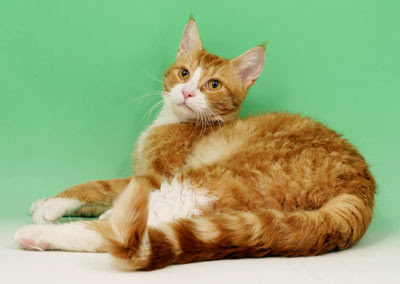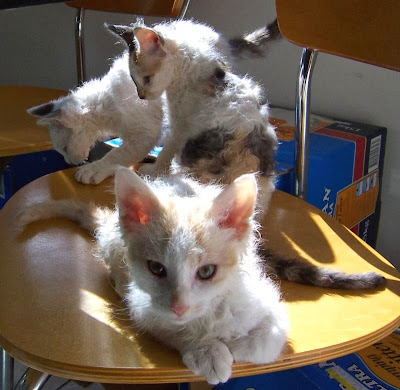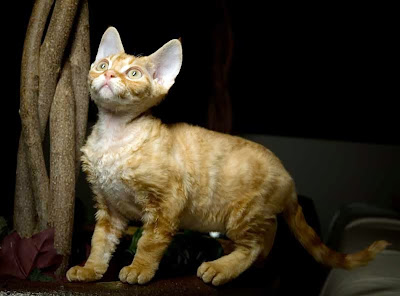Heartworm disease is a serious, potentially life threatening disease in cats. The disease is transmitted by infected mosquitoes that bite the cat and inject the larvae of the heartworm parasite. In the cat, these larvae mature into heartworms in about 6 months. This transmission has to happen through the mosquito to the cat, not from cat to cat. The worms infect the blood vessels of the lungs and heart, causing damage.

There is no treatment approved by the FDA in the United States to treat heartworm disease in cats. The only therapy is supportive, in an attempt to help the cat survive the disease, which lasts 2 to 3 years.
The FDA has approved 4 treatments to prevent heartworm disease in cats: Heartguard for Cats, an oral tablet by Merial. Interceptor, an oral tablet by Novartis. Revolution, a topical by Pfizer. Advantage Multi for Cats, a topical by Bayer.
These 4 treatments do not prevent the infection of the cat by the larvae from the mosquitoes. The treatments kill the larvae in the cat when they are in a particular part of their 6 month life cycle, before they mature into heartworms. Ideally heartworm prevention should be given all year, since the success of the medication depends on killing the larvae at a particular part of its life cycle. Also mosquitoes can survive the cold months indoors and carry the infection to indoor cats even in the winter.
Giving the cat the heartworm prevention monthly should be as easy as possible.
The tablets need to be given with food so they can be absorbed and ideally they should be chewed up. The tablets can be divided into 4 pieces and mixed in with food. Usually reducing the amount of food at that meal and making sure the cat is hungry will let the medication be eaten without being noticed. Some cats like the taste of the tablets and look at them as a treat but they still need to be given with food. If the cat would vomit the meal, contact your vet for instructions on when to give the cat another dose of heartworm prevention.
The topical medications are placed behind the neck. This requires pushing back the fur and squeezing out the liquid directly onto the skin. The manufacturers recommend not getting the liquid on your hands or touching the cat for 2 hours. The medication is placed behind the neck so the cat cannot groom the area. If you have multiple cats, the cat getting treatment must be isolated from the other cats for 2 hours. This prevents them from grooming each other. These topical medications have the advantage of protecting against many other parasites other than just heartworms.
Heartworm disease in cats is widespread, life threatening, and preventable. Please protect your precious companions!
At cattreeparadise.com [http://www.cattreeparadise.com] we adore cats. We have a cat info page on the web site dedicated to articles that will improve the quality of your cat's life. The articles are reviewed by a veterinarian, William Neumann DVM. Also we offer the most creative cat trees that will satisfy your cat's instinctive yearnings. We provide free shipping, a 100% satisfaction guarantee, and great customer service. Our web site, cattreeparadise.com is your best online source for quality cat trees.
Article Source: http://EzineArticles.com/7099823
Do you have a cat? Sometimes get annoyed by their inappropriate favorite sleeping places? Yes, every cat owner must know that they really like warm places, but these habit sometimes can be inconvenient because it is possible that they may sleep in a wrong place, for example: on top of the television, on the bed, in the car, even behind the refrigerator or sometimes, extremely, inside the microwave.

But now, this annoying habit can now be reduced, even eliminated with a device called Cat Heating Pad. A Heating Pad is a place or an electric heated pad that make your cat is able to sleep and curl up comfortably. This Pad size has been adjusted properly so that the cat's body will not become uncomfortable.
There are two types of Cat Heating Pads: Indoor Pad and Outdoor Cat Pad. For Indoor a Warming Pad, some of them is electronically operated, while some of them are using the heat energy from other objects such as ovens, microwaves, or televisions. While for Outdoor Cat Warming Pad, may gain heat from sunlight or the surface where the pad is placed.
If you are the type of person that truly enjoys spoiling your feline companion, then you may consider one of these as a necessary item.
Do not hesitate to use this tool, it is guaranteed safe, your pet would be more calm and it will avoid the damage of your valuables, or your television because your cat already find a warm place to curl and sleep.
Stacy really loves her home and family and lives life to the full and has been writing about her knowledge and experience. Feel free to see some of her material at Small Safe [http://smallsafe.net]
Article Source: http://EzineArticles.com/3705546
The LaPerm is a rex breed which originated in the United States and is now present in many other countries worldwide. The breed is genetically unique and not related to any other rex cat varieties, having a dominant gene causing their curly coats. They have an elegant and athletic build and are affectionate, active and outgoing in character. They are reputed to be hypoallergenic cats, provoking a significantly lower level of allergic response in humans than normal cats. Their most significant feature is their coat, which is made up of soft waves, curls and ringlets, resembling a shaggy perm.

The LaPerm is in many ways a cat of moderation with no extremes and is still true to its original type. It does however have a striking appearance because of its unusual coat. The breed standard describes a muscular foreign-type body, which is medium in size with longish legs and neck. The head is a modified wedge with gently rounded contours and a muzzle which slightly broad of the wedge. In profile the straight nose leads into a gentle break between the eyes up to a flattish forehead. LaPerms also have rather broad noses. Their flared ears are placed to follow the line of the face, while their almond shaped eyes are medium large and expressive.
Like other rexes, all colors and patterns are acceptable,although tabbies, reds and torties are well represented reflecting their origins. Also the unusual colors from the early days of the breed have been selected for, so lilac, chocolate and colorpoints are popular. Tabby points are especially attractive. Newer varieties such as ticked tabbies, shadeds and darker points are also being bred. The curl tends to open up the coat showing off shading, ticking or silver undercoats.
The coat itself is described as having a unique textured feel. It is not silky, having a certain drag on the hand like mohair and the texture comes as much from the shape of the curls as from the mixture of different hair types. It should be soft and inviting, although the shorthairs will have more texture to their coats. The coat is rather loose and bouncy often feeling springy when patted, and stands away from the body with no thick undercoat. It is light and airy and judges sometimes blow on the coat to see if it will part. The coat varies according to the season and the maturity of the cat but is essentially wavy or curly all over with the longest and most defined curls in the ruff and on the neck often falling in ringlets. There is also longer curly fur inside the ears, tufts at the ear tips and “ear muffs”, or longer, silky hair on the backs of the ears. The longhairs have a curly plumed tail while the shorthairs have tails rather like bottle brushes, and both have long curled whiskers. Sometimes the coat falls into a natural parting along the back, jokingly referred to as “the parting of the waves”.
Data refer : http://en.wikipedia.org/wiki/LaPerm








The Devon Rex is a breed of intelligent, short-haired cat that emerged in England during the 1960s. They are known for their slender bodies, wavy coat, and large ears. These cats are capable of learning difficult tricks. They are even known to recognize their owner's name, just as they do their own.
The Devon Rex is a breed of cat with a curly, very soft short coat similar to that of the Cornish Rex. They are often associated with being one of the most hypo-allergenic cats available because of their type of coat. However, they are technically not hypoallergenic.

The first Devon was discovered by Beryl Cox in Buckfastleigh, Devon, UK in 1960 amongst a litter of kittens near a disused tin mine. The breed was initially thought to be linked with the Cornish Rex; however, test mating proved otherwise. Cats have three types of hair: guard hair, awn hair, and down hair. The Devon Rex's coat is unusual because there is little guard hair (see Cornish Rex and Sphynx for more information on hair-deficient genetics in cats).
The curl in Devon Rex fur is caused by a different mutation and gene than that of the Cornish Rex and German Rex, and breeding of a Devon with either of those cats results in cats without rexed (curled) fur. Devons, which are medium sized cats, are often called "pixie cats" or "alien cats" because of their unique appearance. Their uncommonly large, slightly rounded ears are set low on the sides of their wide heads, their eyes are large, and their noses are slightly upturned. Unlike most cats, their whiskers are very short and often curled to such an extent that it may appear as if they have no whiskers. Their body type is distinctly lightly built. Their long, sturdy legs are well suited for long leaps, and their toes are unusually large.
Data refer : http://en.wikipedia.org/wiki/Devon_Rex











When your dog or cat has diarrhea, you want to know why and have the information for what to do and how to treat it. Most cases of acute diarrhea can be handled at home if the symptoms respond well to minimal treatment. Testing to determine the origin is unnecessary. Keep children away from sick dogs, clean messes carefully, and wash thoroughly after handling sick dogs.

Dogs commonly have bouts of acute diarrhea.
Acute diarrhea is when the dog has an abnormal stool that is softer than normal, watery, soft-formed, or soft with abnormal color or very smelly; or when the dog strains to defecate and only passes gas.
There are effective natural remedies.
There are effective natural remedies to support healthy firm stools and maintain "stable stomachs" -- promoting healthy digestion and bowel functioning as well as healthy levels of digestive gas in dogs and cats. Natural treatments for cat and dog diarrhea include probiotics, glutamine, and herbs like slippery elm and plantains.
Diarrhea can result from sudden changes in the dog or cat diet, or when the pet eats something it cannot absorb. It can result from motion sickness or travel stress. Other causes include pancreatitis, parasites such as the Giardia Protozoa and Coccidia (very common invaders of puppies and kittens), Coccidioidomycosis (valley fever), feline distemper virus, bacteria, toxins, and antibiotics. When dogs are unsupervised they are prone to ingest things including sticks, stones and various scavenged items that do not agree with them. The result can be a dog with a case of diarrhea. Don't be alarmed if your dog is acting reasonably well; in most cases the dog's diarrhea is a healthy reaction to help it heal, and not a disease.
It would also not be unusual for a dog (or anyone) with diarrhea to feel "under the weather", so your dog may appear a bit "off" until the diarrhea is resolved. Acute small intestinal diarrhea can be managed by not feeding for 24-48 hours but water must be given, and it is beneficial to add a probiotic powder to the dog's water.
If diarrhea stops, feed small amounts of bland low-fat food 3 to 6 times daily for a few days - foods such as home-cooked boiled hamburger, cottage cheese, tofu with boiled rice, and 100% pure canned pumpkin (NOT pumpkin pie filling with sugars and spices). Most dogs love the flavor of pumpkin. Pumpkin is a unique fiber that regulates the bowel. Be aware, it will color the stool. Foods designed as intestinal diets usually contain rice which is more digestible than other grains. Gradually increase the amount fed in transitioning to the pet's normal diet.
If your canine develops a case of diarrhea and otherwise seems active, content and strong, you can assist the recovery to normal by making some dietary adjustments.
Dogs that have healthy digestive systems are able to eat a variety of foods and that includes raw foods, without resulting diarrhea. Dogs that need to eat a special diet to keep from having diarrhea are not healthy. Do not feed hypoallergenic or bland diets to avoid diarrhea. Find out what the problem is and fix it.
Diagnosis of persistent diarrhea is critical.
Chronic diarrhea is less common and more serious requiring more effort to correct. Diarrhea can be caused by diseases of the small intestine, large intestine or diseases of organs other than the intestinal tract.
If your puppy or kitten has not had its vaccination series and gets diarrhea, call your veterinarian right away. A young puppy with diarrhea usually needs medical attention immediately. Diarrhea can be fatal to puppies under 4 weeks. Green-tinged diarrhea in puppies may indicate Coccidiosis, a parasitic disease that consistently produces diarrhea. Symptoms may include refusal to eat, dehydration, weakness and straining to defecate. See your vet.
Mucus in diarrhea indicates an irritated bowel. Parasites, raw pork hearts and medical conditions can cause mucus in the stool. If the stool is voluminous and continues when you believe the dog should be "empty", call your vet for help in deciding whether you should wait the diarrhea out or make an appointment to have the problem assessed. It may be a bacterial infection.
Diarrhea occurs when an accumulation of dissolved substances in the intestine causes excess water to move into the intestine. This accumulation may be a result of decreased absorption of food, increased secretion of electrolytes by the intestine, or both.
Diarrhea is the dog's body purging itself of harmful or unwanted toxins.
This can be accompanied by vomiting, usually caused by inflammation of the stomach (gastritis), which often happens when dogs eat grass or spoiled food. In some cases of poisoning, vomiting should be induced to get the toxin out of the system as quickly as possible.
If diarrhea is bloody or explosive call your vet. If your dog has a fever or obvious abdominal pain or bloating, this can indicate a serious condition. Contact your vet immediately.
Be sure your pet's fluid intake is maintained, so dehydration does not occur. Dogs with diarrhea can dehydrate quickly. Provide ample fresh water and ensure that your dog is drinking. Dump, wash and refresh the bowl several times daily. Add a probiotic powder to the dog's water, or food. Giving the dog yogurt is soothing but does not provide any significant beneficial bacteria.
If your pet is dehydrated you can usually encourage drinking with a syringe. If your dog is dehydrated and will not drink or is vomiting, call your vet immediately!
We have existed as a company since 1985, but it was a love of dogs, the dogs that have been a part of our life, and the passing of one dog in particular, Rusty, that inspired the creation of [http://www.callofthedog.com] and http://www.CalloftheDogShop.com -- created to provide the things your dogs and pets need. Visit us for great information and quality dog supplies! Be sure to see our About Us page as well.
The two sites are dedicated to the dogs we have loved so deeply, and who have given us so much love in return. Purebreds and mixed breeds, but mostly rescues in need of a home. We educated them, but each one has had something to teach us in exchange.
Article Source: http://EzineArticles.com/1034118























